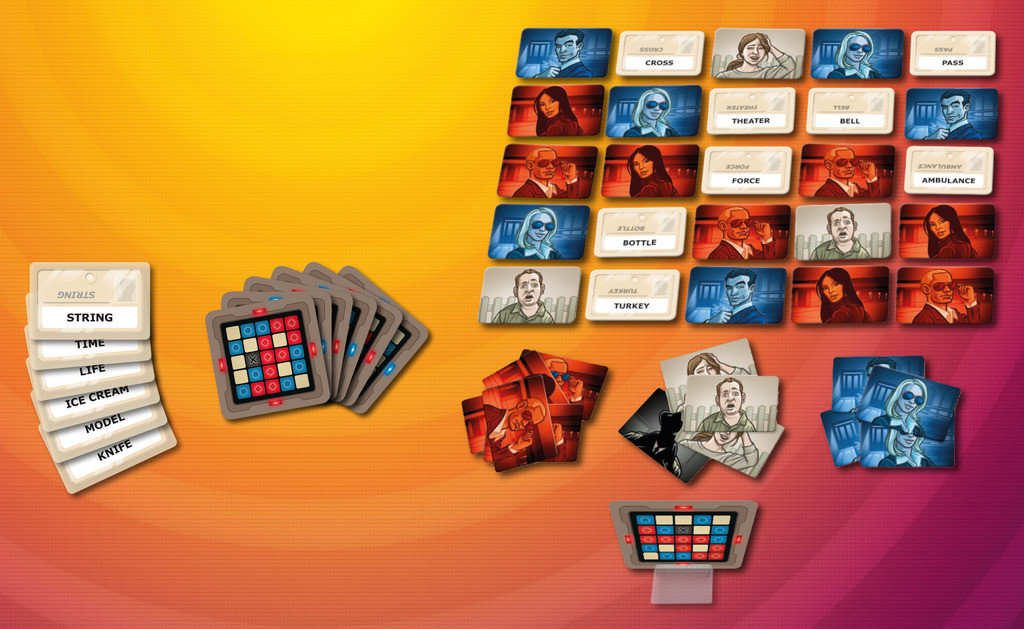It seems like “Codenames” is causing quite a stir among the gaming community as of late so needless to say I had to try it out. In this spy-themed game, you’ll be trying to figure out which code names belong to the agents of your color before the other team can do the same with their own agents. While the game is designed for four or more players (who break up into two teams), you can play a purely cooperative game with simply two people. So queue up the “Get Smart” theme and ready the “cone of silence”, for only the most clever team will find their agents first.
Components
The game includes 8 Red Agent Cards, 8 Blue Agent Cards, 1 Double Agent Card, 7 Innocent Bystanders Cards, 1 Assassin Card, 40 Key Cards, 200 Double-sided Codename Cards, 1 Sand Timer, and a rule book.
Setup & Gameplay
The game can be played cooperatively or competitively. I’ll opt to cover the latter, as the co-op rules are more of a variant to the base game.
Firstly, players break off into teams of two (one red, one blue). One player from each time will be designated as the spymaster, both of whom will sit next to each other. The spymasters will then randomly choose a key card, sharing it between them and only them. Twenty-five codename cards are drawn at random and placed into a 5×5 grid. The double agent card is flipped to the color of the team going first (the key card will indicate who goes first). The first team to contact all of their agents, wins the game.
On a team’s turn, the spymaster will give a one word clue followed by a number. The use of a sand-timer is optional. The word should relate to the codenames of their color, while the number indicates how many codenames fit that clue.
Example: Two of your words are NUT and BARK. Both of these grow on trees, so you say “tree: 2”.
The rest of the players on that team will coordinate and guess one of the codename cards, hoping it belongs to an agent of their color.
- If the field operative touches a card belonging to his or her team, the spymaster covers the word with an agent card in that color. The team may guess another word (no extra clue is given!).
- If the field operative touches an innocent bystander, the spymaster covers it with an innocent bystander card. This ends the turn.
- If the field operative touches a card belonging to the other team, the word is covered by one of the other team’s agent cards. This ends the turn. (And it helps the other team.)
- If the field operative touches the assassin, the word is covered by the assassin card. This ends the game! The team that contacted the assassin loses.
Play continues until one team manages to reveal all of the agents of their color. The team who does, wins the game! It could also end if one team reveals the assassin, in which case that team loses.
Editor’s Note: The above doesn’t cover all of the rules found in the manual, but should give you an idea as to how the game is played.
The Review
This might sound kind of odd, but I actually enjoy the two player co-op variant just as much (if not more) than the core game. That’s not to say that the game itself isn’t a lot of fun, mind you…I just tend to like team-building / cooperative games a bit more than competitive ones. Those of who you have kids may be able to relate…it’s much more fun as a family to collectively beat a game that has no hard feelings when it loses. The gameplay mechanics themselves are easy to learn, so no worries if you’re a casual gamer easily intimidated by other games you’ve come across in your travels.
I’m a sucker for games that employ some type of stealth / who-done-it mechanic, like “Clue: The Great Museum Caper” or the more simplistic “Guess Who?” There’s just something about looking at a grid and knowing that one wrong move will end the game for you. “Minesweeper” addicts know what I’m talking about. I’m pleased to report that I had a similar experience here when I wasn’t the spymaster. When you are the spymaster, everything changes and instead of worrying about which codename to pick, you’ll have to come up with the most efficient one-word clues possible. You’ll have to tread carefully though, as some players like to make connections from clues that are so round-about that even you didn’t think of it. As such, sometimes saying “tree-2” is better than say, “tree-5”.
“Codenames” is an outstanding game. When opting for the core rules, it’s better suited for parties…the more people you have playing, the better. When opting for the cooperative rules, then it serves well with two players. Three player games can be either or, with one person being a field operative for both sides while the other two spymasters attempting to win the game for their color team. Alternatively, the three players could simply team up like in a two player game. I’ve seen the price fluctuate on Amazon from $15-$30…I’d say $20 is fair for what you’re getting here so try to find it for that price or less if you can.
Final Verdict: 9/10
—

